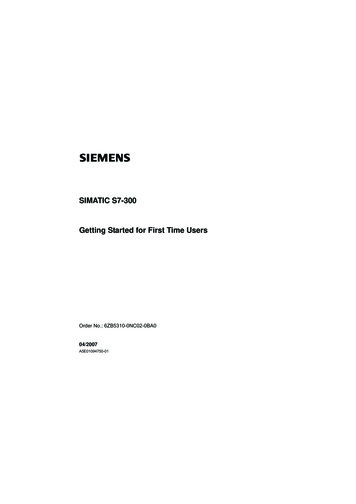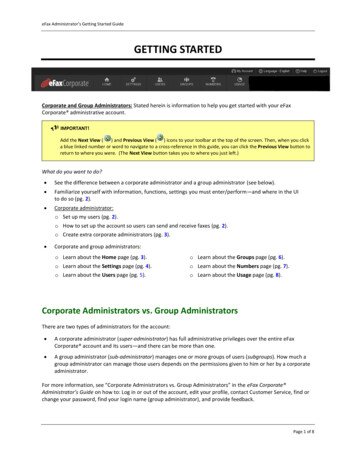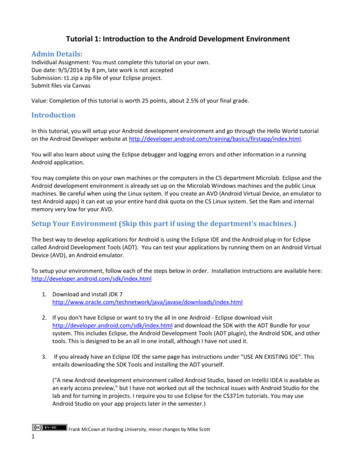
Transcription
GETTING STARTEDWITH INTELLIJ IDEA ASAN ECLIPSE USERBY ANTON ARHIPOVtneitapmiFor t he escapeesEclipseAll rights reserved. 2014 ZeroTurnaround OÜ1
TABLE OF CONTENTSINTRODUCTIONWHY INTELLIJ IDEA 1-4CHAPTER IGETTING YOUR FIRST INTELLIJ IDEA PROJECT SET UP5-12CHAPTER IIGETTING COMFORTABLE WITH IDEAS'S KEYMAP,NAVIGATION AND SETTINGS 13-34CHAPTER IIIGETTING PRODUCTIVE WITH TESTS, DEPLOYMENTSAND ARTIFACTS 35-40CHAPTER IVSUMMARY, CONCLUSION AND GOODBYE COMIC ;-)All rights reserved. 2014 ZeroTurnaround OÜ41-43Clnoitcesotick to g o2
INTRODUCTION:WHY INTELLIJ IDEA?Coffee or Tea? Mac vs. PC? iPhone OS or Android?Eclipse or IntelliJ IDEA (or NetBeans)? Believe itor not, software developers argue as much abouttheir IDE as any of these other hotly-debated topics.And for a good reason.All rights reserved. 2014 ZeroTurnaround OÜ3
Confessions of an IntelliJ addictMy name is Anton, and I’m an IntelliJ IDEA addict.Whew, it feels good to say it out loud. The choice of IDEfor developers is one of the most contentious debates inthe software game. Unless you have a darn good reason,you don’t often use more than one IDE, let alone all threeof the major IDEs in the Java world: Eclipse, IntelliJ IDEAand NetBeans.The truth is that I have been a happy IntelliJ IDEA (for the sake of brevity andlaziness, you’ll see IntelliJ IDEA referred to in full, as well as simply “IntelliJ”and “IDEA” as well from here on) user since 2004—a full decade. Over thelast 10 years, I have always been discovering the new aspects of the IDEand I’m always waiting for the new version release with an excitement.But why? After all, aren’t all IDEs more or less the same? (BOOO! HISSSSS!)Was there something that happened in my past to make me so dedicated tothis particular IDE?Well, before settling on IDEA, I had worked with Eclipse and NetBeans, evenchampioning Eclipse at one point in my former job. But by using IDEA andEclipse almost side by side for some time I realized that IDEA supports thework I was doing much better. Eventually, I dodged other IDEs and decidedto become a full-time IDEA user. When I joined ZeroTurnaround, my newrole required me to learn all IDEs in-depth due to the fact that our flagshipproduct, JRebel, ships as an IDE plugin for Eclipse, NetBeans, IDEA, andJDeveloper. My primary IDE is IntelliJ IDEA and my teammates think of me asof an IntelliJ IDEA addict.Now it might be only my impression, but back then IDEA had the bestrefactoring capabilities. These days, I think it still is more consistent in termsof UX, and there are shortcuts for almost every action. Not to mention itunderstands the source code context better than others. Subjectively, itmade me more productive, but this kind of depends on the set of featuresthat you, as a developer, need and want. If the IDE matches what youactually use then it is probably the best IDE for you :)All rights reserved. 2014 ZeroTurnaround OÜ2
The Java IDE market landscapeHere you can see a recent breakdown of the IDE landscape(as of 2012). We are planning to survey developers again in2014 for new stats, but most likely, things haven’t changedthat drastically. Note: Answers were non-exclusive and askeddevelopers to select IDEs in use, not single selections only).As you can see, I’m not alone. Close to 1/3 of Java developersthat we surveyed in 2012 use IDEA on at least some projects.However, neither IDEA nor third-place NetBeans compare toEclipse, which clearly dominates the scene. Understandably,Eclipse is an advanced tool that is completely free and opensource (as is NetBeans), whereas you have to pay to get themost out of IDEA. Wait, what?Yep. What makes IDEA different is that was a commercialonly tool until 2009, when IntelliJ IDEA 9 was released. Nowwe have both Ultimate and Community editions. CommunityEdition is free and open source and Ultimate Edition is acommercial product and builds on top of Community Editionand offers more features and support.A number of features are provided only in the commercialdistribution and in this guide we assume that you willtry Ultimate Edition when evaluating the IDE. Thecommunity edition is enough for Java and even for Androiddevelopment, but you will miss a lot of cool features. Seethe full comparison of the two IDEA versions at the officialproduct page: http://www.jetbrains.com/idea/features/editions comparison matrix.htmlAll rights reserved. 2014 ZeroTurnaround OÜ3
What you’ll see in this reportMy main purpose in writing this report is to show Eclipse users, specifically,how to get started using IDEA faster and with less headaches.Perhaps you are Eclipse users who are interested in trying out IntelliJ IDEA,or perhaps considering the migration. Moving from Eclipse to IDEA can bequite overwhelming. People usually neither have patience nor time to learnnew IDE with its own set of shortcuts. Even more - in some cases it requireschanging your mindset about how you use your IDE. With this guide, mygoal is to point out the main differences when moving from Eclipse to IDEAso that the path wouldn’t be as painful.I have seen a lot of my colleagues going from Eclipse to IntelliJ IDEA. Theystruggled initially, but survived. In a few days or weeks they didn’t want tocome back to their previous IDE. Naturally, I have tried to help a lot of myfriends to migrate to IDEA and with this guide I’d like to help YOU as well.So, I’ve broken it down into a few chapters. In Chapter I, we’ll talk aboutgetting your project set up right, Chapter II looks at keymap, navigation andeditor settings, and Chapter III covers more advanced things like testing,deploying and artifacts. So, let’s get started!All rights reserved. 2014 ZeroTurnaround OÜ4
CHAPTER I:GETTING YOUR FIRSTINTELLIJ IDEA PROJECT SET UPLet’s start the guide with getting your first projectset up. You wouldn’t be able to give IDEA a try ifyou don’t have a project opened, right? Instead ofcreating a new project, you most likely will need toopen—or import—an existing one.All rights reserved. 2014 ZeroTurnaround OÜ5
Cloning and importing the project from a Git repositoryLet’s clone a sample project from https://github.com/zeroturnaround/petclinic. This is a Petclinic web application based on the Spring framework.1.VCS Checkout from Version Control Git2.In the dialog, enter the repository URL and the destination folder.Click Clone to import the project.All rights reserved. 2014 ZeroTurnaround OÜ3.Once the project sources are cloned, the IDE will ask if you wantto open the project because it discovered Maven’s pom.xml.In addition to Maven, IDEA also detects Gradle and Eclipseconfiguration files.6
If you had another project opened, the IDE will ask if you want toopen it in a separate window.Note: If you're an Eclipse user, for now just assume that"Project" in IntelliJ IDEA is the same as "Workspace" in Eclipse,and "Module" in IntelliJ IDEA is the same as "Project" in Eclipse.As an Eclipse user, you might be confused here—why would you need toopen a project in another IDE window? This is not how the things work inEclipse. With IntelliJ IDEA, you can have an IDE window per project. We willsee more details about this a bit later in the Projects vs Modules part.4.Voila! You’re done! As you have confirmed to open the project atthe previous step, the project imports automagically and is readyto be hacked on. Keep in mind that after the project import, it willtake some time for IDEA to index your project files. Later you’ll getthis time back using smart code assistance.All rights reserved. 2014 ZeroTurnaround OÜ7
Project Structure and ConfigurationProject structure and configuration in IntelliJ IDEA is very different fromEclipse. Almost everything—from project structure, folder management,how the packages are represented in the project tree, and this terminologyissue with projects vs modules—looks really weird to an experiencedEclipse user. In this part, we will highlight the important aspects of theproject structure and configuration.FOLDERSEvery project module can include a number of folders that can behandled differently.When importing the project from a model (e.g. in the case of a Mavenproject) IDEA automatically discovers the source, test and resources folders.You can also set the folder type manually by selecting the appropriateoption via the Mark Directory As context menu by right-clicking on the folderin project view.The project tool window can be accessed with Alt 1 / Cmd 1 shortcut. Hereis a quick key for defining the meaning of folder labels:Source - marks the folder as a source rootTest - marks the sources as testsExcluded - If you mark a folder as ignored it won’t display inthe project tree and its contents will not be indexed. Note thatyou might want to exclude a folder if there are a lot of big files,otherwise it can cause a bit of performance penalty for theindexer.Resources - The new type of folders introduced in IDEA 13 the resources folder. The contents of the resource folder areautomatically copied to the compiler’s target folder.Under External Libraries you will find all the dependencies for the module.All rights reserved. 2014 ZeroTurnaround OÜ8
The project view can be adjusted according to your preferences.For instance, the way the packages are displayed, or if you would like toautoscroll to the source when selecting a resource in the project view, etc.All rights reserved. 2014 ZeroTurnaround OÜTo get the detailed overview of all the modules, libraries and othersettings related to the project, open the Project Structure dialogCtrl Shift Alt S / Cmd ;9
The modules view in the Project Structure dialog provides a full overview ofthe folder types in the selected module. Note that the Java language levelcan also be configured per module, i.e. one module could use Java 5 syntax,but you may want to set it to Java 7 for the other oneFor defining the compilation target folder there are two options: either putevery module’s compiled classes to the same location, or use a modulespecific location, which can be overridden.Dependencies can be specified in a variety of ways. For a Maven project,IDEA just automatically imports the dependencies specified in pom.xml andstores the list in an *.iml file in the root of the module. Alternatively, it ispossible to tell IDEA to save the list in Eclipse-specific format.The official IntelliJ IDEA documentation explains what are the specificconfiguration files for a project — , and a module — odules may have the references to other modules as well. It is similar tospecifying the required project dependency in the Java Build Path in Eclipse.All rights reserved. 2014 ZeroTurnaround OÜ10
FACETSOnce the project is opened and after the initial scanning, IDEA will tell youthat it has detected some artifacts and will suggest that you set some facetsfor the module, which are like little configuration assistants.Facets are used to streamline the project configuration in IDEA, and theyencapsulate the support for a variety of frameworks, technologies andlanguages. For instance, a tool—let’s use JRebel as an example of shamelessplug—can be set up to add its own facet to configure specific properties fora module. You can see below the JRebel facet there, just like you have forSpring. Now you can configure web-specific properties for the module.By clicking the Configure link in the popup, it will bring out a dialog withthe list of configurations IDEA suggests for you to configure (i.e. Hibernate,Spring, JPA, etc).Interestingly, facets exist in Eclipse too, but for some reason thisconfiguration method isn’t adopted very widely. In contrast to Eclipse, IDEAusers depend on facets as a really common way of configuring modules.All rights reserved. 2014 ZeroTurnaround OÜ11
MODULES VS PROJECTSNow, back to the Modules vs Projects dilemma. Before, I wrote that youshould think of IDEA projects as of Eclipse workspaces. This analogy is goodenough for the beginning, but it isn’t exactly correct, as projects in IDEA arenot generally used in the same way as Eclipse workspaces.In Eclipse, you would usually put a lot of different projects into the sameworkspace and then filter them with Working Sets or by closing the projectsthat aren’t relevant at the moment. That said, in Eclipse workspaces arerarely used for grouping arbitrary projects. Workspaces are used ratheras a common root and the projects are added to or removed from theworkspace. The average Eclipse user would have a limited number ofworkspaces in the file system.In contrast, IDEA’s project is an umbrella for logically connected modules,whereas the modules are rather similar to Eclipse projects with the onlydifference that IDEA modules can be nested within the project tree.A module is a part of the project that can be built independently.Normally, you wouldn’t put the disconnected modules under the sameproject. Technically, you can, but that’s not idiomatic. You would ratheropen a new IDE window with the second project than importing anothernon-related module into the existing project.All rights reserved. 2014 ZeroTurnaround OÜ12
CHAPTER II:GETTING COMFORTABLEWITH IDEA’S KEYMAP,NAVIGATION AND SETTINGSGet ready to make a list! In this chapter, we go overin detail all the shortcuts you’ll need to effectivelyget started with IDEA, and highlight the majordifferences that might befuddle Eclipse users atfirst.also, we may have a cheatsheet for you.All rights reserved. 2014 ZeroTurnaround OÜ13
ACTIONWINDOWSOS XACTIONWINDOWSOS XCode completionCtrl Space SpaceBasic completionCtrl Space Space---Smart completionCtrl Shift Space SpaceQuick accessCtrl 3 3Search everywhereShift 2 x2Maximize active view or editorCtrl M MHide all tool windowsCtrl Shift F12 F12Open typeCtrl Shift T TNavigate to classCtrl N NNext viewCtrl F7 F7------Recent filesCtrl E E---SwitcherCtrl TabQuick outlineCtrl O OFile structureCtrl F12 F12Move linesAlt Up/Down Move linesAlt Shift Up/Down Delete linesCtrl D DDelete linesCtrl Y YQuick fixCtrl 1 1Show intention actionAlt Enter Quick switch editorCtrl E ESwitcherCtrl Tab---Recent filesCtrl E EQuick hierarchyCtrl T TNavigate to type hierarchyCtrl H H---Navigate to methodhierarchyCtrl Shift H H---Show UML popupCtrl Alt U ULast edit locationCtrl Q QLast edit locationCtrl Shift BackspaceNext editorCtrl F6 F6Select next tabCtrl Left ---SwitcherCtrl Tab---Recent filesCtrl E ERunCtrl Shift F11 F11RunF10F10All rights reserved. 2014 ZeroTurnaround OÜ 14
ACTIONWINDOWSOS XACTIONWINDOWSOS XCorrect indentationCtrl I IAuto-indent linesCtrl Alt I IFormatCtrl Shift F FReformat codeCtrl Alt L LOpen resourceCtrl Shift R RNavigate to fileCtrl Shift N NSurround withCtrl Alt Z ZSurround withCtrl Alt T T---Surround with live templateCtrl Alt J JOpen declarationF3F3Navigate to declarationCtrl B B---Quick definitionCtrl Shift I IOpen type hierarchyF4F4Navigate to type hierarchyCtrl H----Show UML popupCtrl Alt U UReferences in workspaceCtrl Shift G GFind usagesAlt F7 F7---Show usagesCtrl Alt F7 F7---Find usages settingsCtrl Alt Shift F7 F7Open search dialogCtrl H HFind in pathCtrl Shift F FCopy linesCtrl Alt Down Duplicate linesCtrl D DExtract local variableCtrl Alt L LExtract variableCtrl Alt V VAssign to fieldCtrl 2,F 2,7Extract fieldCtrl Alt F FShow refactor quick menuCtrl Alt T TRefactor thisCtrl Shift Alt T TRenameCtrl Alt R RRenameShift F6 F6Go to lineCtrl L LNavigate to lineCtrl G GStructured selectionAlt Shift Up/Down Select word at caretCtrl W/Ctrl Shift W W/ WFind nextCtrl J KFind nextF3F3Show inCtrl Alt W WSelect inAlt F1 F1BackCtrl [ [BackCtrl Alt Left ForwardCtrl ] ]ForwardCtrl Alt RightAll rights reserved. 2014 ZeroTurnaround OÜ 15
The KeymapKey bindings is something that gets welded into the backbone ofdevelopers—this is probably one of the hardest parts about migrating toone IDE from another. The most painful thing is when you hit a shortcutthat performs a completely different (and often harmful) action than whatyou expect. If you are Eclipse user, try hitting Ctrl D / Cmd D in IntelliJIDEA: you will realize the issue immediately!Of course, you can change the bindings of your keymap in IDEA. This is assimple as pressing Ctrl and selecting a preferred keymap. You can selectbetween Eclipse, NetBeans, Emacs key bindings and some more.Even though you can change the key bindings to the ones from the IDEthat you’re familiar with, it doesn’t seem to be a good idea."What I screwed up when trying IntelliJ IDEAis that I changed to Eclipse shortcuts and thenI didn't know what the key for Alt Enter is."ERKKI LINDPERE - Typist"I went over keymap and assigned the most wiredkey-bindings from my Eclipse days. Especiallyif they didn't collide with anything important."OLEG SHELAJEV - Product EngineerAs we figured, the best strategy is to stick with the default key bindings andonly change those handful of shortcuts that are really welded into yourmuscle memory and you can’t help yourself but hitting the wrong keys.There are many shortcuts in IntelliJ IDEA, for navigation, editing, refactoringand more. In the following section, we’ll go over the most important keybindings that you most likely will need.Before we proceed to the main part, let’s bring up the shortcuts that causethe most annoyance to ex-Eclipse users.All rights reserved. 2014 ZeroTurnaround OÜ16
CTRL W / CMD WOne single shortcut that probably annoys Eclipse users the most is theblock selection shortcut. Ctrl W / Cmd W is used to gradually expandthe selection of code."I wish Ctrl W did what I expect it to do :("ADAM KOBLENTZ - Senior Pre-Sales Engineer"You should be aware of the auto-save featureand know what are you doing to enjoy it.For example, our small Play 1 application tries toreload everything when IDEA saves file (becauseit works on the source code level). In the sameway I suspect any interpreted language behavioursomewhat cripples the usefulness of autosave."OLEG SHELAJEV - Product EngineerBut hey! The reason you want to use Ctrl W / Cmd W is actually irrelevantif you learn the zen of not closing the tabs — we’ll cover that in the Dealingwith Tabs part later. If you develop a habit when you don’t have to closethe tabs, you can then use Ctrl W / Cmd W for something else, i.e. forcode selection.CTRL D / CMD DThis is, arguably, the second most-annoying shortcut. In Eclipse, thisshortcut is used for deleting the line. In IntelliJ IDEA, ‘D’ stands for ‘duplicate’.To delete a line, use Ctrl Y / Cmd Y instead.CTRL S / CMD SYou do not have to save changes in IDEA: autosave works incredibly well.Just forget about saving the files as if it is a bad habit. Stop. Hitting. Ctrl S."We also are now trying to promote OSX 10.5 keyboard binding on OSX to make OSX usersfeel more at home."HADI HARIRI - DeveloperYeah, indeed, Ctrl W is usually used to close a tab or a window of anapplication. And IDEA decided to reserve this shortcut for something else:code selection.All rights reserved. 2014 ZeroTurnaround OÜ17
NavigationThe default look of IntelliJ IDEA is quite minimalistic. Starting from version13 it doesn’t even include the toolbar in the default UI configuration.All rights reserved. 2014 ZeroTurnaround OÜIf you’re a new user and just starting to learn the IDE, you would probablywant to switch on the toolbar as well as the tool window buttons.However, these control elements take up some space from the workingarea and as you learn the navigation shortcuts, you will most likely hidethese elements after a while.18
Even more: the navigation bar with the launch buttons that is enabled bydefault could be hidden too and accessed later with shortcuts.TOOL WINDOWSTool windows provide an insight to all kinds of project aspects. For instance,there’s the Project view, Structure view, Maven Projects view, etc. So, toolwindows are instrumental to the "I" in "IDE" .First, to quickly access these views, some of the tool window buttonshave numbers and can be accessed with Alt NUMBER / Cmd NUMBERshortcuts. As project view is probably the most important one, thenAlt 1 / Cmd 1 is a reasonable shortcut for this matter.Recent Files popup, invoked via Ctrl E / Cmd E, is also handy for navigatingbetween tool windows.Navigation bar can be invoked via Alt HomeObviously, with all the tool controls closed you need to have access withshortcuts and that’s what makes navigation in IntelliJ IDEA quite pleasant.Now let’s get our hands dirty. Assume that the our IDE workbenchis in default setup and start discovering the navigation tricks.All rights reserved. 2014 ZeroTurnaround OÜ19
Also the Switcher popup, invoked with Ctrl Tab, could be used for the samepurpose. However, the mechanics of navigation are a bit quirky in Switcher,thus navigating via the Recent Files popup is more convenient.Sometimes, I need to navigate from the file in editor to a tool windowrelated to the current file. Alt F1 opens a special popup that can be usedto jump to any of the tool windows that are relevant. Probably the mostcommon case is when you want to find out where the current file is locatedin the project structure. For that, Alt F1 and hit Enter—and the currentlyopen file will be highlighted in the project tree.BASIC NAVIGATIONNavigation through the source code is one of the activities that weprogrammers execute on a regular basis. Let's see what the navigationfeatures are in IntelliJ IDEA.Probably the most popular navigation feature is the ability to navigate toa particular class, invoked with Ctrl N / Cmd N.Similarly, the Navigate to File action is accessible withCtrl Shift N / Cmd Shift N.This action can actually be used to navigate to a folder in the project tree byadding a slash to the end of the search pattern.The official documentation provides sophisticated information about thesettings for the tool windows in IntelliJ -idea-tool-windows.htmlAll rights reserved. 2014 ZeroTurnaround OÜ20
Next, you can also Navigate to Symbol, Ctrl Shift Alt N / Cmd Shift Alt N,to navigate to a specific class, method or a field. I find this action to be a bitslow however, and therefore I don’t use it as often.DEALING WITH EDITOR TABSYou might have noticed a pattern in the shortcut definitions by now:Let’s go to Settings Editor Editor Tabs.ActionWindowsMac(Mac OS X layout)Navigate to ClassCtrl NCmd NNavigate to FileCtrl Shift NCmd Shift NNavigate to SymbolCtrl Shift Alt NCmd Shift Alt NBefore getting to more interesting navigation, it is a good idea to talk a lookon the editor tabs behavior.Protip: Note that for Mac there are two keymaps available:Mac OS X keymap, and Mac OS X 10.5 keymap, which is morelike the Eclipse keymap. So, you might want to switch to it.Arguably, the most useful shortcut is the most accessible one, with viathe Ctrl / Cmd key. Then, by adding the Shift key to the mix you accessthe second useful shortcut. And by adding more keys to the combination—Alt, in the case above—you proceed to the advanced actions.All rights reserved. 2014 ZeroTurnaround OÜMy zen for the editor tabs is that there shouldn’t be more than one row oftabs in the editor view, but at the same time I do not want the tabs to starthiding once they don’t fit in one line. So I usually set the tab limit to a fairlysmall number, depending on the screen size, and leave the tabs dismissingpolicies to whatever is default.21
By the way, the behavior of the tabs closing is somewhat different fromEclipse, so you might want to change that."Default strategy for closing tabs in idea is peculiarat least. 10 open tabs with average java classnames, that are not arranged into a single row,take half of the screen on my laptop and annoyme enough to be the first thing I change after afresh install. Other than that, settings are flexibleenough to allow tweaking for any sensible taste."OLEG SHELAJEV - Product EngineerIn general, navigation between editors rarely involves clicking on tabs.So I prefer a minimal in-your-face appearance: no package names, no uglystars for unsaved files, no close buttons, single row, close unused tabsoften, open most recent tab to preserve linearity of movements history.BTW, you can do a quick search in the Recent Files popup as well! Just starttyping and the search will filter out the irrelevant entries.If you know that you have edited the filerecently, there’s a bit better option that youcan use - Recently Edited Files, accessed withCtrl Shift E / Cmd Shift E.MORE NAVIGATION TO FILESYou may be confused by now about why you would restrict yourself on thenumber of tabs opened. In big projects, you might need to navigate througha lot of files and by closing the tabs would would have to find and openthem again. So that seems inconvenient.But have no fear! There is a better solution for navigation that I suggest youget familiar with.IDEA has some actions that are very handy for navigation when you haveto keep yourself in the context of many files. Ctrl E / Cmd E pops up theRecent Files list. The default number of files kept in the buffer is 50.All rights reserved. 2014 ZeroTurnaround OÜArrows can be used for navigation between tabs, but also for navigating thecursor position history.Ctrl and Ctrl allows you to navigate between tabs as they areopened in the editor. That’s a pretty basic navigation feature. However, IDEAmaintains the history of the cursor positions within the files as we have beenbrowsing through the code. So it is possible to get back to the position in thecode even if we don’t remember which exact file it was. Use Ctrl Alt and Ctrl Alt for navigating over the cursor positions history.22
Über ActionsLearning all the shortcuts at once can be quite overwhelming. You have toexercise them a lot to get comfortable with the new keymap and bindings.However, there are a few shortcuts that you absolutely have to remember!ALT ENTERAnother purpose of Alt Enter is to invoke intentional actions. For instance,place the a cursor to a method modifier, hit Alt Enter, and the popup willsuggest you to convert the modifier from public to private, protected ormake it package-local. Plugins can also contribute to intentions and add thespecific actions to the context.Alt Enter in IntelliJ IDEA is as universal as Ctrl 1 / Cmd 1 in Eclipse. If fixesthings, but it can also suggest intentions “out of the blue”!Whenever something is highlighted as a warning or error, use Alt Enterand IDEA will help you out. But you can also hit Alt Enter in almost anypart of the code and a little popup will suggest actions that you can performwithin the current context."My recommendation,try hitting Alt Enter more often."OLEG SHELAJEV - Product EngineerAll rights reserved. 2014 ZeroTurnaround OÜRead more about the intention actions in the official lay/IntelliJIDEA/IntentionsBut what if you simply cannot remember all the shortcuts? Have nofear! You can find the actions by name as well as the settings, using theCtrl Shift A / Cmd Shift A. This popup can be quite useful becauseyou probably don’t have all the actions assigned with shortcuts.23
SEARCH EVERYWHEREBROWSING THE CODEThe newest addition to IntelliJ IDEA super-shortcuts is Search Everywhere.Double clicking the Shift button will invoke the relevant popup.Search Everywhere combines several shortcuts in one:There are plenty of shortcuts for navigating over the source code in IntelliJIDEA. There are shortcuts used for file navigation, but they are definitely notenough for a professional software developer.1.At the very start, it shows the list of recently opened files,same as Ctrl E / Cmd E.2.Next, when you start typing, it starts displaying the resultsfor classes, files, members, actions and IDE settings.Within the opened Java class, you can easily navigate to the specific methodusing the class outline popup, invoked via Ctrl F12 / Cmd F12.For you Eclipse users out there, Search Everywhere reminds me ofCtrl 3 / Cmd 3 in Eclipse, however it behaves a little bit differently.All rights reserved. 2014 ZeroTurnaround OÜ24
To inspect the type hierarchy of the type/class that is under the cursor, hitCtrl H to open the type hierarchy tool window with the relevant class graph:One of the most common ways to navigate the code is to follow thereferences. Ctrl B / Cmd B will probably be your beloved shortcut for thispurpose; it’s same as F3 in Eclipse.Finding the usages for a field, class, method or a local variable is anothervery common activity while browsing the source code. In IDEA, there areseveral shortcuts that are used for this task:Ctrl Alt H does the same for the method call hierarchy.Use Alt F7 to find all usages and display the results in a Find tool window."Compared to Eclipse, I’m actually missing theability to see the call hierarchy for the fields. InIntelliJ IDEA I can view the call hierarchy if I invokethe action on a getter to the field, but not if I trydoing the same on a field itself."PAVEL GRIGORENKO - Research EngineerSo, let there be more shortcuts!All rights reserved. 2014 ZeroTurnaround OÜ25
Ctrl Alt F7 / Cmd Alt F7 finds all usages and displays the resultsin a popup:While typing into the search action popup, you will notice more navigationaction types: Goto by Name Actions, which we covered previously, andGoto Error/Bookmark Actions, are for navigating to the warnings or errorsin the currently opened file.Often you don’t really want to navigate anywhere, but just quickly lookupthe method definition, or maybe Javadoc?By using Ctrl Shift F7 / Cmd Shift F7 you will highlight the usages withinthe current file:Ctrl Shift I allows you to lookup the source code almost from any place inthe IDE. Obviously, you can lookup the code from the editor:To learn about all possible reference n
petclinic. This is a Petclinic web application based on the Spring framework. 1. VCS Checkout from Version Control Git 2. In the dialog, enter the repository URL and the destination folder. Click Clone to import the project. 3. Once the project sources are cloned, the IDE will ask if you want










